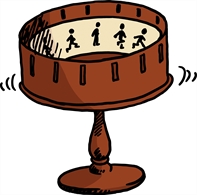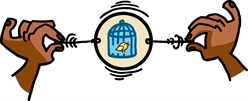- Modules
- History of Animation
- Optical Toys
Optical Toys
T-PRIN-001-003
An optical toy is an item that uses persistence of vision to fool the eye into perceiving a series of still images, one shown quickly after the other, as a continuous moving image.
The Zoetrope
The zoetrope creates the illusion of a moving picture. The first zoetrope was created in China, while the modern zoetrope, essentially a cylinder with vertical openings around the circumference, was invented in 1834 by Englishman William George Horner. Affixed to the inside edge of the circumference are a series of pictures that, when viewed through the openings of the spinning cylinder, appear to form a seamless moving image.

The Thaumatrope
This optical toy was invented by the English physician John A. Paris in 1825. The thaumatrope is a simple disc with two different pictures on each side. Strings are attached to each side of the disc and when pulled, the disc spins and the images appear to merge, creating a single illustration.

The Flip Book
The first flip book was invented in 1868 by John Barnes Linnet. This was another device that relied upon the illusion of movement to suggest a seamless moving image. A flip book is a set of printed or drawn pictures, featured in sequence on the pages of a book. When the pages of the book are flipped at high speed, it creates an illusion of movement.

The Praxinoscope
The praxinoscope was invented by French photographer Emile Reynaud in 1831. This device was a more advanced version of the zoetrope, also relying on a spinning cylinder, now fixed with a series of mirrors. Reynaud also developed a larger version of the praxinoscope, so he could project the moving pictures onto a screen.
Time Estimated 10 mins
Difficulty Level Beginner